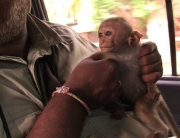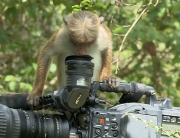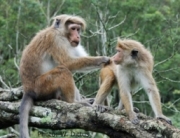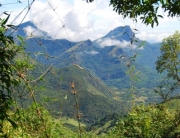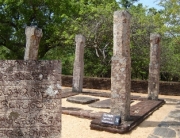Validating Skinfold Thickness as a Proxy to Estimate Total Body Fat in Wild Toque Macaques (Macaca sinica) Using the Mass of Dissected Adipose Tissue
WOLFGANG P. J. DITTUS1,2 & K. A. SUNIL GUNATHILAKE2
Skinfold thickness (SFT) has been used often in non-human primates and humans as a proxy to estimate fatness (% body fat). We intended to validate the relation between SFT (in recently deceased specimens) and the mass of adipose tissue as determined from dissection of fresh carcasses of wild toque macaques (Macaca sinica). In adult male and female toque macaques body composition is normally 2% adipose tissue. Calipers for measuring SFT were suitable for measuring only some subcutaneous deposits of adipose tissue but were not suitable for measuring large fat deposits within the body cavity or minor intermuscular ones. The anatomical distribution of 13 different adipose deposits, in different body regions (subcutaneous, intra-abdominal and intermuscular) and their proportional size differences, were consistent in this species (as in other primates), though varying in total mass among individuals. These consistent allometric relationships were fundamental for estimating fatness of different body regions based on SFT. The best fit statistically significant correlations and regressions with the known masses of dissectible adipose tissue were evident between the SFT means of the seven sites measured, as well as with a single point on the abdomen anterior to the umbilicus. SFT related to total fat mass and intra-abdominal fat mass in curvilinear regressions and to subcutaneous fat mass in a linear relationship. To adjust for differences in body size among individuals, and to circumvent intangible variations in total body mass allocated, for example to the gastro-intestinal contents, dissected fat mass was estimated per unit body size (length of crown-rump)3. SFT had greater coefficients of correlation and regressions with this Fat Mass Index (g/dm3) than with Percent Body Fat.
American Journal of Primatology 77:618–632, 2015. © 2015 Wiley Periodicals, Inc.
DOI: 10.1002/ajp.22385
1 Conservation Ecology Center, Smithsonian Conservation Biology Institute, Washington, DC, USA
1 National Institute of Fundamental Studies, Kandy, Sri Lanka
2 Association for the Conservation of Primate Diversity, Polonnaruwa, Sri Lanka

